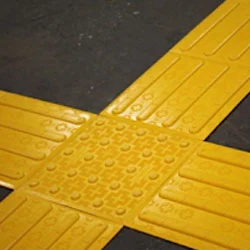









As a leading supplier of tactile solutions in Canada, we understand the importance of selecting suitable tactile warning systems to enhance accessibility and safety in indoor facilities. With various options now available, choosing compliant and durable tactile products suited to your unique requirements can get overwhelming.
This blog provides a comprehensive guide to finding the ideal tactile solutions for any indoor facility – whether it's a commercial space, transit hub, institutional building, residential condo, or complex. We'll overview everything from product types and key standards to material options and installation methods. Read on for insights into specifying the best tactile warning systems for your next project.
Indoor tactile warning systems, also called Tactile Walking Surface Indicators (TWSIs), provide critical navigation cues and hazard warnings for pedestrians with visual impairments or other disabilities. Installing compliant tactile surfaces is mandated under accessibility legislation like the Accessibility for Ontarians with Disabilities Act (AODA).
Two main types of tactile solutions are used indoors:
Durable and thoughtfully placed tactile warning systems foster confidence, allowing people with disabilities to navigate unfamiliar indoor environments independently and safely.
Here are key considerations when choosing tactile solutions for an indoor facility:
With the factors above guiding selection, next explore available system options matching your needs:
Cast Iron Tactiles: Extremely durable metal tiles embeddable into concrete offer longevity in high-traffic locations. However, more costly and rigid material limits custom shapes.
Specify durable and compliant tactile warning systems indoors with these leading options from Tactile Solution Canada:
The AccessTile Replaceable Cast-In-Place tactile system from Access Products combines engineered polymers and intelligent design for the ultimate replaceable tactile tile. These lightweight composite tiles are embedded directly into fresh concrete, delivering industry-leading replaceability. Available with truncated dome textures or wayfinding bars.
Also, from Access Products, the AccessTile Surface-Applied tiles retrofit onto existing cured concrete—the durable polymer tactile feature beveled edges for a smooth transition and easy compliance with accessibility codes. Choose from attention domes assisting the visually impaired or wayfinding bars options.
ArmorTile Cast-In-Place truncated dome systems consist of vitrified polymer composite tiles that lead the industry in strength, durability, and weather resistance when embedded in new concrete builds. It fully meets ADA/CSA/ISO standards and has ten high-visibility color choices.
Similarly, the Surface-Applied ArmorTile tactile tiles from ArmorTile consist of durable polymer composites that can easily be retrofitted onto existing concrete. These non-slip tiles suit a variety of indoor applications needing visual contrast and tactile warnings.
Elan Porcelain Stoneware Tactiles made from premium natural materials surpass durability standards for long-lasting indoor performance. The porcelain tactile domes and wayfinding bars add aesthetic elegance to any commercial, institutional, or public space needing accessible design.
Eon flexible rubber tactile suit transit facilities, hospitals, and malls for heavy traffic environments. State-of-the-art polymers provide contemporary styling and category-leading quality matched with anti-slip textures that promote accessibility.
When selecting tactile solutions, first confirm all accessibility compliance based on the system's intended application within your facility. Work with manufacturers to get recommendations aligned to your specifications - surface type, high vs low foot traffic durability needs, required tactile texture, available dimensions, and any unique spatial constraints. We at Tactile Solution Canada offer a diverse range of the aforementioned top brands of tactile warning systems so you can find ideal options matching both form and critical function. Consult our product experts as a trusted resource in finding the best solutions for your next project.
For essential hazard warnings or interior wayfinding, investing in compliant and durable tactile warning systems brings immense value, enhancing safety, accessibility, and experience for all users.
Here are answers to some common questions about indoor tactile solutions:
Cast-in-place tactile tiles are embedded directly into freshly poured concrete, making them integral to the floor surface. Surface-applied systems adhere to existing cured concrete floors, allowing retrofit application.
Indoor areas like transit platforms, top/bottom of stairs, escalators, elevators, exit pathways, wide corridors, and lobbies typically need compliant tactile warning strips for hazard caution or wayfinding.
Quality indoor tactile tiles generally last 10-15 years. Heavy-duty cast metal or porcelain systems can have even longer lifespans of 20+ years. Higher foot traffic areas may require tile replacement every 5-8 years for polymer-based products.
Indoor tactile surfaces mainly just require routine cleaning as per the flooring around them. Some replaceable tile types allow convenient section-by-section replacement if damage occurs over time rather than replacing entire applications, saving costs.
Tactile warning systems installed along interior exit pathways generally need fire protection conforming to the National/Ontario Building Code. Fire-rated tactile products meeting flame spread/smoke development requirements are available.
Specifying compliant and durable tactile warning systems for facilities ranging from transit hubs to office towers is key for accessibility and safety. With creative solutions now available matching both form and critical function, selecting durable, tactile products specifically meeting your spatial needs is vital. Work with experts to find ideal options - whether porcelain tiles add contemporary elegance or composite products balance affordability and strength. Connect with the pros at Tactile Solution Canada today for lasting safety enhancements compliant with codes and standards.
